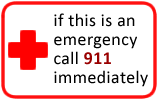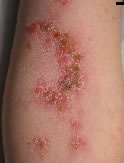Impetigo - Infected Sores
Impetigo - Infected Sores
Does this describe your child's symptoms? |
Click image for more info |
Definition
Symptoms
Cause
Return to School
|
If not, see these topics
|
When to Call Your Doctor |
Call Your Doctor Now (night or day) If |
|
|
|
Call Your Doctor Within 24 Hours (between 9 am and 4 pm) If |
|
|
|
Call Your Doctor During Weekday Office Hours If |
|
|
|
Parent Care at Home If |
|
|
HOME CARE ADVICE FOR MILD IMPETIGO |
Reassurance:
Impetigo is a superficial skin infection that usually starts in a scratch or insect bite.
It usually responds to treatment with any antibiotic ointment.
Remove Scabs: Soak off the scab using an antibacterial soap and warm water. The bacteria live underneath the scab.
Antibiotic Ointment: Apply an antibiotic ointment 3 times per day (no prescription needed).
Examples are Bacitracin or Polysporin or one you already have.
Cover it with a Band-Aid to prevent scratching and spread.
Repeat the washing, ointment and Band-Aid 3 times per day.
Avoid Picking: Discourage scratching and picking which spreads the impetigo.
Contagiousness:
Impetigo is contagious by skin to skin contact.
Wash the hands frequently and avoid touching the sore.
For mild impetigo (1 or 2 sores), can attend school or child care if it is covered.
For severe impetigo, child needs to take an oral antibiotic for more than 24 hours before returning to school.
Contact Sports: Generally, needs to receive antibiotic treatment for 3 days before returning to the sport. There can be no pus or drainage. Check with team's trainer if there is one.
Expected Course: Sore stops growing in 1 to 2 days and skin is healed in 1 week.
Call Your Doctor If:
Impetigo increases in size after 48 hours on antibiotic ointment
New impetigo sore occurs on antibiotic ointment
Not completely healed in 1 week
Your child becomes worse
And remember, contact your doctor if your child develops any of the "Call Your Doctor" symptoms.
Updated:
March 22, 2017





